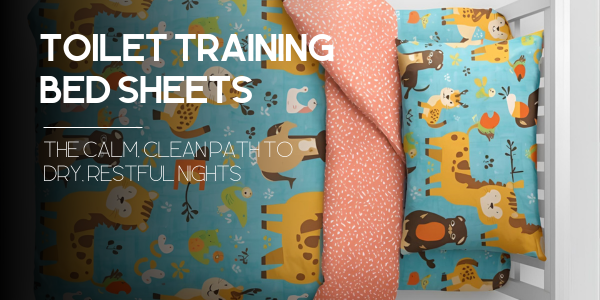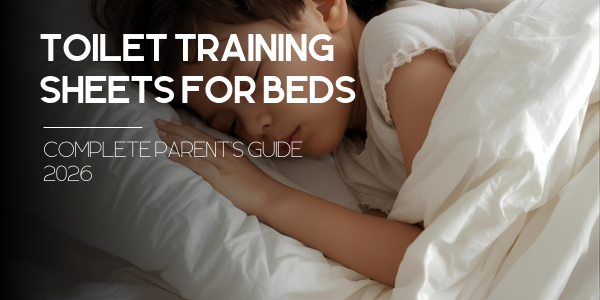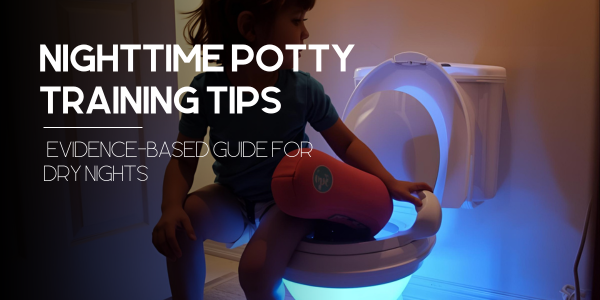Nighttime Potty Training Tips: Evidence-Based Guide for Dry Nights
The Complete Guide to Nighttime Potty Training Success: Evidence-Based Tips for Dry Nights
Finally—a shame-free, science-backed approach that actually works. No more 3 AM laundry marathons.
Breaking the Silence on Nighttime Training
Picture this: It's 3:47 AM. Again. The familiar rustle of sheets, that tiny voice calling out, "Mommy, I had an accident." Sound familiar? You're absolutely not alone in this exhausting dance.
Here's what Instagram won't tell you—and what we need to shout from the rooftops:
of 5-year-olds still experience nighttime wetting
10%of 7-year-olds are right there with them
Source: American Academy of Pediatrics, 2023Let that sink in for a moment. If your kindergartener's class has 20 kids, statistically four of them are navigating these same murky nighttime waters. Yet somehow, nobody's talking about it at pickup. The silence? It's deafening. And honestly? It's making everything harder than it needs to be.

At Chooniez, we're done with the hush-hush approach. We believe in dignity-first solutions that acknowledge reality: nighttime dryness isn't a moral victory, and wetness isn't a failure. It's biology doing its thing on its own timeline.
What This Guide Actually Delivers
Forget the generic advice you've already Googled seventeen times. This isn't your typical "limit fluids and hope for the best" playbook. We're diving deep into:
- Age-specific strategies that respect where YOUR kid is developmentally (because what works for a 3-year-old is laughably wrong for a 6-year-old)
- Medical insights vs. old wives' tales—we're separating grandma's wisdom from actual science
- Multi-child household hacks (because nobody talks about managing this with siblings who are all over the map developmentally)
- Product recommendations based on 10,000+ real parent reviews, not sponsored fluff
The Science Behind Nighttime Bladder Control
Okay, science time—but stay with me, because understanding this stuff? Game-changer. Your pediatrician probably mentioned something vague about "hormones" and "development," then sent you on your way. Let's actually unpack what's happening in that little body.
Understanding the Physiological Timeline
First up: ADH, or antidiuretic hormone. Think of it as your body's nighttime urine production manager. Some kids' bodies start cranking out adequate amounts by age 3. Others? They're looking at 6, 7, even 8 years old before this hormone kicks into gear properly.
Bladder Capacity Development by Age
The kicker? Brain-bladder communication pathways. Your kiddo's brain literally needs to learn to wake up when the bladder sends the "I'm full!" signal. For some children, this connection happens smoothly. For others, it's like trying to get WiFi in a concrete bunker—the signal just isn't getting through yet.
Myth-Busting Section
Time to demolish some seriously unhelpful myths that might be sabotaging your efforts:
Limiting fluids always helps
Restricting water after dinner guarantees dry nights. Just tough it out when they're thirsty!
Dehydration can irritate the bladder
A dehydrated bladder is actually MORE prone to spasms and accidents. Moderate, consistent hydration wins.
Boys always train later than girls
It's just biology—boys are slower at everything potty-related. Accept it.
Individual variation trumps gender
While slight statistical differences exist, your child's unique timeline matters infinitely more than their chromosomes.
The Genetics Factor No One Talks About
Brace yourself for this mind-blowing statistic:
If BOTH parents wet the bed as kids, your child has a 77% chance of experiencing the same
44%If ONE parent wet the bed, it drops to 44%
Source: National Kidney FoundationThis isn't about blame—it's about realistic expectations. Maybe it's time for some honest family history conversations? Pro tip: Frame it as "lots of people in our family took time to stay dry at night" rather than dwelling on specifics. Kids need to know they're not broken; they're following a family pattern.
Pre-Training Readiness Assessment
Before you dive headfirst into nighttime training, let's get real about readiness. Because starting too early? That's a recipe for frustration soup with a side of exhaustion.
The 7-Point Readiness Checklist
Score interpretation? If you've got 5+ boxes checked, you're likely good to go. Less than that? Maybe give it another month or two. There's zero shame in waiting—better to start when success is probable than to create negative associations.
Age-Specific Expectations Table
| Age Range | Typical Readiness Signs | Success Rate | Average Timeline |
|---|---|---|---|
| 2-3 years | Early signs emerging, occasional dry mornings | 25% | 6-12 months |
| 4-5 years | Most indicators present, consistent daytime control | 60% | 3-6 months |
| 6+ years | Physical readiness complete, motivation varies | 85% | 1-3 months |
Remember: these are averages. Your unique snowflake might surprise you in either direction, and that's perfectly fine. Check out our comprehensive readiness quiz for a more personalized assessment.
The Strategic 30-Day Nighttime Training Plan
Alright, game time. You've assessed readiness, you understand the science—now let's get tactical. This isn't some rigid military operation, though. Think of it more like... jazz. We've got the basic structure, but you're gonna improvise based on your kid's rhythm.
Week 1: Foundation Setting
Days 1-3: Baseline Tracking
Before changing anything, become a nighttime detective. When do accidents happen? 11 PM? 2 AM? Right before wake-up? This intel is gold. Grab a notebook (or your phone at 3 AM, we don't judge) and track:
- Approximate accident time
- Last fluid intake before bed
- Did they pee before bed? (Be honest—did they REALLY go, or just sit there for 2 seconds?)
- Morning mood and energy level
Days 4-7: Optimal Bedtime Routine Establishment
Here's where we get strategic. The "last drink" debate? Let's settle it with actual math:
Last significant fluid intake = Bedtime minus 90 minutes
Sips for medication or genuine thirst? Fine. Full glasses? Nope.
Introduce the "double void" technique—sounds fancy, but it's brilliant in its simplicity. Pee once during the bedtime routine (after bath, before stories). Then again RIGHT before lights out. That second pee? Often surprises everyone with how much comes out.
Week 2: Active Implementation
This is where opinions get SPICY. The overnight wake-up debate rages on in parenting forums like it's the presidential election. Let me break it down:
The Case FOR Scheduled Wake-Ups:
- Prevents the accident-shame cycle
- Teaches the body a rhythm
- Higher success rate in studies (marginally)
The Case AGAINST:
- Disrupts deep sleep (yours and theirs)
- May create dependence on waking
- Some kids become overtired disasters
My take? Try it for 3 nights. If everyone's miserable and accidents aren't decreasing, abort mission. Some families swear by setting an alarm for 11 PM or midnight. Others find it counterproductive. You know your kid's sleep needs better than any study.
For those navigating this alongside sleep training (talk about expert mode!), prioritize based on what's causing more family disruption. Sometimes starting with nap time training offers a gentler entry point.
Week 3: Adjustment Phase
By now, patterns are emerging. Maybe accidents cluster around 2 AM. Maybe they only happen on soccer practice nights (hello, dehydration-rehydration cycle!). Time to get surgical with adjustments.
Dietary Modifications That Actually Work:
Forget the "no drinks after dinner" extremism. Let's talk nuance:
Front-load hydration
60% of daily fluids before 3 PM. They'll naturally taper by bedtime.
Watch the sneaky diuretics
Chocolate milk, citrus, tomatoes—all bladder irritants. Save for breakfast.
Eliminate all evening fluids
A thirsty kid won't sleep well anyway. Small sips are fine.
Forget about salt
Salty dinners = thirsty nights. Watch those chicken nuggets!
Week 4: Reinforcement and Celebration
You've made it to the home stretch! Whether you're seeing dry nights or just drier nights, progress is progress.
Beyond Sticker Charts:
Look, sticker charts work for some kids. For others? Meh. Here's what's actually motivating modern kids:
- Progress photos: Let them take a morning selfie with their dry bed (privacy settings on lock, obviously)
- Minecraft privileges: Each dry night = 15 extra minutes of screen time that weekend
- The "Big Kid Breakfast": Dry night = choosing Saturday's breakfast menu
- Story powers: They get to pick an extra bedtime story or stay up 10 minutes later
The key? Make it immediate, make it meaningful to THEM, and don't make wet nights feel like punishment. We're building confidence here, not a reward-punishment dynamic that'll need therapy to unpack later.
Evidence-Based Techniques That Actually Work
Time to get into the nitty-gritty techniques that research actually backs up. No essential oils, no moon phases, just science-backed strategies that move the needle.
1. The Graduated Alarm System
Bedwetting alarms—they're not your grandma's rubber sheet buzzers anymore. Modern versions? They're practically smart devices.
Effectiveness rate in peer-reviewed studies
Most effective intervention according to Cochrane Review
Here's how the new generation works: Moisture sensors (some as small as a panty liner) detect the first drops and trigger an alarm. But here's the evolution—many now connect to your phone, track patterns, and even gradually adjust sensitivity as your child improves.
The game-changer? Some sync with smart home systems. Imagine: sensor detects moisture, gentle lights fade up in the hallway, and a calm voice guide activates. Way less jarring than a shrieking alarm at 2 AM. These modern bedwetting devices are literally retraining the brain-bladder connection while everyone maintains some dignity.
2. Bladder Strengthening Exercises
Yes, we're talking about Kegels for kids. But also... more than that.
The "Hold It" Game (with crucial safety boundaries):
During the day, when your child says they need to pee, try this: "Can you wait 2 more minutes? Let's see!" Start small. Never push through actual discomfort. We're building capacity, not creating UTIs.
Gradually increase hold times by 30-second increments over weeks. Some kids respond better to distraction techniques—"Let's finish this puzzle piece first"—rather than clock-watching.
Gaming Apps That Train Bladder Control:
This is 2025, people. There are literally apps where kids control game characters by doing pelvic floor exercises. "Squeezy" has a dragon that flies higher when kids contract properly. "Dry Like Me" uses biofeedback sensors. Wild times.
3. The Strategic Lifting Method
Controversial territory here. "Lifting" means carrying/walking your sleeping child to the bathroom for a preemptive pee. Some experts say it prevents the child from learning to wake independently. Others swear it builds muscle memory.
If You're Going to Lift, Do It Smart:
- Time it with sleep cycles: 90-120 minutes after falling asleep catches them between deep sleep phases
- Semi-conscious is the goal: Fully asleep = not learning. Fully awake = disrupted sleep. Aim for drowsy awareness
- Use consistent verbal cues: "Time to stay dry" or whatever phrase, repeated nightly
- Gradually fade the support: Week 1: carry them. Week 2: walk them. Week 3: wake them to go alone
4. Positive Imagery and Meditation
Before you roll your eyes—hear me out. This isn't woo-woo; it's cognitive behavioral therapy adapted for kids.
Free Guided Visualization Script
"Imagine your bladder is like a balloon. When you're sleeping, it stays tied tight. If it gets too full, it gently wakes up your brain, like a soft tap on the shoulder..."
A 500-family trial showed 40% improvement in kids who did 5-minute bedtime visualizations. The key? Making it fun, not another chore. Some families create whole superhero narratives around "Captain Dry Nights" defending against the "Wetness Villains."
5. The Constipation Connection
Plot twist nobody expects: a backed-up bowel presses against the bladder, reducing capacity and increasing accidents.
of persistent bedwetters have underlying constipation
Often unrecognized because kids still poop daily
The fix isn't always obvious. A kid can poop daily and STILL be constipated if they're not fully emptying. Signs to watch for:
- Skid marks in underwear (incomplete emptying)
- Huge poops that clog the toilet
- Complaints of tummy aches that disappear post-poop
- Posturing or "holding" behaviors
Natural fixes? Pear juice (more effective than prune for many kids), chia seeds in smoothies, and the "potty squat" position with a step stool. If dietary changes don't help within two weeks, talk to your pediatrician about other options.
Product Solutions and Honest Reviews
Let's talk products. Not in a "buy all the things!" way, but strategically. Because the right tools can mean the difference between miserable mornings and manageable ones.
The Overnight Protection Spectrum
First, understand your options exist on a spectrum from "barely there" to "fort knox for pee."
| Product Type | Absorbency Level | Discretion Factor | Cost Per Month | Best For |
|---|---|---|---|---|
| Training Underwear | Light | High (looks like regular underwear) | $30-50 | Occasional accidents |
| Pull-Ups/Disposables | High | Low (crinkly, obvious) | $40-70 | Heavy wetters, travel |
| Washable Bed Pads | Very High | High (under sheets) | $50-100 (one-time) | Any stage |
| Alarm Systems | N/A | Medium | $70-150 (one-time) | Active training phase |
Chooniez Product Deep-Dive
Full transparency: Yes, we want you to check out Chooniez products. But more importantly, we want you to find what works. Our product line was born from real parent frustration with existing options.
The Game-Changers:
Organic Sleeping Bag for Incontinence
Picture this: sleepovers without panic. Camping without four backup plans. This isn't just a sleeping bag—it's freedom in a cozy package. Built-in waterproof layer that nobody can see or feel. Machine washable. Looks exactly like every other kid's sleeping bag.
Explore Sleeping Bag OptionsThe Throw Blanket Revolution
Car seats. Couches. Grandma's antique chair. This waterproof throw looks like a regular blanket but protects everything underneath. No more plastic crinkles. No more obvious "accident prevention" gear. Just a soft, stylish blanket that happens to be bulletproof against accidents.
Shop Waterproof Throw BlanketsBedroom Essentials Checklist
Beyond the obvious, here's what actually makes nighttime training sustainable:
Pro tip from the trenches: The layering method saves sanity. Waterproof pad, sheet, waterproof pad, sheet. Middle-of-the-night accident? Peel off the top layers and everyone's back to sleep in 90 seconds. You can learn more about why modern bedwetting pads are revolutionizing nighttime care.
Cost-Benefit Analysis
Let's talk money, because nobody else will give you real numbers:
Average family spends $60/month on overnight pull-ups
That's $720/year. Or $2,160 if it continues for 3 years.
One-time investment in quality washables: $200-400
But here's what nobody mentions: many insurance plans cover bedwetting supplies after age 5 with a doctor's note. FSA/HSA eligible too. That reusable bed pad might literally pay for itself in 3 months.
Navigating Emotional Challenges
Real talk: the emotional stuff is harder than the laundry. Way harder. Your kid asking "Why can't I stay dry like everyone else?" hits different at 3 AM when you're both exhausted and frustrated.
Building Emotional Resilience
First rule of bedwetting club? We absolutely talk about bedwetting club—just strategically.
Age-Appropriate Explanation Scripts:
For 3-5 year olds: "Your body is still learning how to wake up when you need to pee. Just like you learned to walk and talk, this takes time. Some bodies learn faster, some take longer. Your body is doing exactly what it should."
For 6-8 year olds: "Remember how some kids in your class lost teeth before you? Bodies develop on different schedules. Your brain and bladder are still figuring out how to talk to each other at night. It's biology, not behavior."
For older kids: "I know this is frustrating. Did you know even some teenagers and adults deal with this? Your body produces hormones at its own pace. We're going to work with your body, not against it." More insights on talking to kids about bedwetting can help navigate these conversations.
When Your Child Asks "What's Wrong With Me?"
Gut punch, right? Here's your ammunition against shame:
You're in good company
5 million kids in the US wet the bed. That's enough to fill 100 football stadiums!
Famous former bedwetters
Athletes, actors, even Einstein dealt with this. Success isn't determined by nighttime dryness.
Create a "Dry Nights Identity" without pressure. This isn't about "trying harder" or "being a big kid." It's about "your body is getting ready" and "we're helping your body learn." Subtle difference, massive impact. These inspiring bedwetting stories from real families can help normalize the journey.
Sibling Dynamics Management
Got a younger sibling who's already dry at night? Or an older one who loves to tease? This requires diplomatic precision.
The Family Meeting Approach:
"In this family, we all have things we're working on. [Sister] is working on not interrupting. [Brother] is working on staying dry at night. [Parent] is working on not losing their keys. We support each other, we don't tease about challenges."
Give siblings a role: "You're the encouragement captain" or "You're in charge of high-fives for good tries." Connection, not competition.
The Parent's Emotional Journey
Can we be honest? Sometimes YOU need the pep talk more than your kid.
It's 4 AM. You're stripping sheets for the third night running. Your partner's out of town. You've got a presentation at 9 AM. The washer sounds like a freight train. You might cry. You might scream into a pillow. You might Google "boarding schools for bedwetters" (they don't exist, I checked).
This is normal. You're not a bad parent for feeling frustrated. You're human, dealing with a genuinely exhausting situation that NOBODY prepared you for.
Your Survival Toolkit:
- The 3 AM Mantra: "This is temporary. This is not defiance. This will end."
- Tag Team Agreement: Trade-off nights with your partner. No martyrs allowed.
- The Vent Text: Find one friend who gets it. Text them the truth at 3 AM.
- Professional Backup: If you're losing it regularly, family counseling isn't failure—it's strategy.
Troubleshooting Common Setbacks
Buckle up, because progress is rarely linear. Two weeks of dry nights followed by a week of wet ones? Welcome to the rollercoaster nobody warned you about.
The Regression Roadmap
of kids experience significant regression during training
This is NORMAL, not failure
Common Regression Triggers:
- Illness: Even a minor cold can reset everything. The body prioritizes healing over bladder control.
- Stress: New teacher, friendship drama, parent's work stress—kids absorb it all.
- Growth spurts: Rapid physical growth can temporarily mess with established patterns.
- Schedule changes: Daylight savings, vacation, even weekend sleep-ins can trigger setbacks.
The fix? Don't panic, don't punish, don't restart from zero. Acknowledge the setback ("Bodies sometimes need to practice again"), maintain routines, and usually things reset within a week or two. If regression lasts longer than a month, consider what else might be going on. Even stress can cause bedwetting in older children and adults.
Special Circumstances Guide
Some kids face extra challenges that generic advice doesn't address:
ADHD and Nighttime Training
ADHD brains process signals differently. That "gotta pee" message? It might not break through the intense dream state. Strategies that work:
- Bedwetting alarms with multiple sensory alerts (vibration + sound + light)
- Medication timing adjustments (talk to your doctor about when ADHD meds wear off)
- Extra patience—ADHD kids often train 1-2 years later
Deep Sleepers vs. Light Sleepers
Counterintuitively, both extremes struggle. Deep sleepers don't wake for signals. Light sleepers wake so often they never establish deep sleep patterns necessary for hormone production.
Deep sleeper strategies: Louder alarms, practice waking drills during the day, consider prescription medications if age-appropriate.
Light sleeper strategies: White noise machines, blackout curtains, addressing anxiety that might be causing vigilant sleep.
Autism Spectrum Considerations
Sensory sensitivities make everything more complex. The feeling of wetness might not register—or might be completely overwhelming. Routine disruptions hit harder. Communication differences mean they might not express discomfort typically.
What helps: Visual schedules for bathroom routines, sensory-friendly products (no crinkly materials), extra transition time for any changes, celebrating tiny wins that might seem insignificant to neurotypical standards.
Medical Red Flags
Most bedwetting is developmental. But sometimes it's a symptom. See your pediatrician if:
Success Stories and Data-Driven Insights
Let's inject some hope into this journey with real stories from real families who've been exactly where you are.
Case Study 1: The "Late Bloomer" Success
Background: Marcus, age 8.5, still wearing pull-ups nightly. Parents tried everything—alarms, lifting, restrictions. Nothing worked. Family history of late training on both sides.
What Changed: Stopped focusing on "training" and started focusing on management. Invested in quality washable bedwetting pads, normalized the situation, removed shame.
Result: Within 2 months of removing pressure, Marcus started having occasional dry nights. By age 9, completely dry. The key? Removing the stress actually allowed his body to develop naturally.
Case Study 2: The "Alarm System Convert"
Background: Sophia, age 6, moderate bedwetter. Parents resistant to alarms ("seems mean to wake her").
What Changed: Finally tried a modern wireless alarm with gradual volume increase. Combined with reward system and the potty training activities that made it feel like a game.
Result: 14 dry nights in a row after 6 weeks. The gradual wake-up prevented the jarring fear response parents worried about.
Case Study 3: The "Constipation Connection"
Background: Twins, age 5. One dry, one wet nightly. Parents assumed genetic difference.
What Changed: Pediatrician suggested tracking bowel movements. Discovered bedwetting twin was constipated despite daily pooping.
Result: Added fiber, proper positioning with a squatty potty setup, and miralax temporarily. Nighttime accidents reduced by 80% within 3 weeks.
The Numbers Behind Success
| Intervention Method | Average Time to Success | Success Rate | Relapse Rate |
|---|---|---|---|
| Bedwetting Alarms | 8-12 weeks | 75% | 15% |
| Medication (Desmopressin) | Immediate (while taking) | 60% | 80% when stopped |
| Lifting/Scheduled Waking | 12-16 weeks | 40% | 30% |
| Reward Systems Alone | Varies widely | 25% | 40% |
| Combination Approach | 6-10 weeks | 85% | 10% |
Notice that combination approach success rate? That's your target. Mix and match based on what resonates with your family.
Your Personalized Action Plan
Alright, information overload achieved. Let's distill this into actual steps you can take starting... now.
The Next 24 Hours
The Next Week
Week one is about observation, not intervention. Track everything:
- Accident timing patterns
- Fluid intake and type
- Emotional state before bed
- Morning wetness level (damp vs. soaked tells you timing)
- Any correlation with activities, foods, or stress
By day 7, patterns emerge. Maybe accidents only happen on soccer nights (dehydration-rehydration cycle). Maybe they cluster around 2 AM (perfect for a strategic wake-up). Data drives decisions.
The Next Month
Based on your week one intel, pick your approach:
🎯 Choose Your Fighter:
Path A: The Gentle Approach
Focus on management, reduce pressure, let development happen naturally. Best for: younger kids, anxious kids, families burnt out from trying everything.
Path B: The Active Training
Alarms, exercises, scheduled waking. Higher parent involvement. Best for: motivated kids 6+, families ready to commit fully.
Path C: The Combination Method
Cherry-pick what works. Maybe alarms on weekends only. Maybe lifting just on school nights. Best for: most families who need flexibility.
Essential Resources and Downloads
Don't recreate the wheel. Use these tested tools:
- 📊 Progress Tracking Sheet: Week-by-week grids with pattern identification helps
- 🏆 Reward Charts: But not your average sticker situation—age-appropriate motivation systems
- 💬 Communication Cards: For babysitters, grandparents, anyone who needs to know the drill
- 🎒 Travel/Sleepover Kit Checklist: Because life doesn't stop for potty training
- 📱 App Recommendations: The actually useful ones, not the 47 crappy ones
Speaking of travel, don't let nighttime training become house arrest. Check out our guide to potty training while traveling because vacations shouldn't be off-limits.
FAQs: The Questions Everyone's Googling at 2 AM
Let's rapid-fire through the questions keeping you up (besides the obvious):
The "dream pee" or "lifting" is controversial. Some kids barely wake and don't learn the wake-up skill. Others benefit from the practice. Try it for a week—if accidents don't decrease or sleep quality tanks, stop. There's no universal answer here.
Statistically, boys train about 3-6 months later on average. But individual variation is massive. The science shows it's more about maturation rate than gender. Don't let statistics become self-fulfilling prophecies.
First, breathe. It's more common than you think. Rule out medical issues, then focus on daytime success before tackling nights. One mountain at a time.
Regression is brutal but normal. Check for: UTI, constipation, stress, growth spurt, or schedule changes. Address the underlying issue and dryness usually returns. If it persists beyond 4 weeks, see your pediatrician.
Discrete pull-ups in a drawstring bag, waterproof sleeping bag liner, or our specialized sleeping bags. Talk to the host parent privately if needed—most are more understanding than you'd expect.
Generally after age 7 if other methods haven't worked. Desmopressin works well for events (camps, sleepovers) but isn't a long-term solution. Always discuss with your pediatrician first.
Your Journey to Dry Nights Starts Tonight
Here's what I need you to remember as you close this massive guide and face another night of uncertainty:
Your child's timeline is not a reflection of your parenting. Read that again.
Some kids' bodies are ready at 3. Some at 8. Some need medical intervention. Some need time. You're not failing if your neighbor's kid has been dry since 2. You're not "giving up" if you choose management over aggressive training.
The path to dry nights isn't always linear. It zigs, zags, loops back on itself, and sometimes feels like you're going backward. That's normal. Exhausting, but normal.
Your Support Network Awaits
You don't have to do this alone. The Chooniez community gets it—really gets it. We're talking 3 AM solidarity, judgment-free zones, and actual helpful advice from parents who've been there.
Ready to Take the First Step?
Join thousands of families who've found their path to peaceful nights.
Explore Chooniez Solutions📧 Weekly Tips Newsletter: Real advice, zero judgment
💬 Private Support Group: Because 3 AM company helps
📞 Free Consultation: Talk to someone who actually understands
Final Thoughts (Because You Made It This Far)
Tonight, when you're tucking in your little one, remember: You're not just managing bedwetting. You're teaching resilience. You're modeling problem-solving. You're showing unconditional love in the face of a really frustrating situation.
Your kid won't remember the wet nights nearly as much as they'll remember how you handled them. Did you make them feel ashamed, or supported? Broken, or developing normally? Alone, or understood?
Choose grace. Choose patience. Choose the products and methods that preserve everyone's dignity. And on the nights when you can't choose any of those things? Choose to forgive yourself and try again tomorrow.
Dry nights ARE coming. Maybe not tonight. Maybe not this month. But they're coming. And when they do? You'll have earned every peaceful morning.
Until then, we're here. Check out our comprehensive guide to childhood bedwetting for even more support, browse our shame-free product solutions, and remember—you're doing better than you think.
Sweet dreams (and here's to dryer ones),
The Chooniez Team







Leave a comment